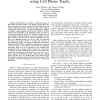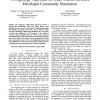CSE
2009
IEEE
14 years 6 months ago
2009
IEEE
—We introduce a new data set which contains both a self-declared friendship network and self-chosen attributes from a finite list defined by the social networking site. We prop...
CSE
2009
IEEE
14 years 6 months ago
2009
IEEE
CSE
2009
IEEE
14 years 6 months ago
2009
IEEE
—We introduce a novel set of social network analysis based algorithms for mining the Web, blogs, and online forums to identify trends and find the people launching these new tren...
CSE
2009
IEEE
14 years 6 months ago
2009
IEEE
—Social Network Analysis (SNA) has evolved as a popular, standard method for modeling meaningful, often hidden structural relationships in communities. Existing SNA tools often i...
CSE
2009
IEEE
14 years 6 months ago
2009
IEEE
Interobserver reliability and reproducibility are well known problems in experimental research within the social and behavioural sciences. We propose the use of formal techniques ...
CSE
2009
IEEE
14 years 6 months ago
2009
IEEE
—We describe a semantic imitation model of social tagging that integrates formal representations of semantics and a stochastic tag choice process to explain and predict emergent ...
CSE
2009
IEEE
14 years 6 months ago
2009
IEEE
—Mobile devices can produce continuous streams of data which are often specific to the person carrying them. We show that cell phone tracks from the MIT Reality dataset can be u...
CSE
2009
IEEE
14 years 6 months ago
2009
IEEE
—Reputation mechanisms are essential for online transactions, where the parties have little prior experience with one another. This is especially true when transactions result in...
CSE
2009
IEEE
14 years 6 months ago
2009
IEEE
—The stigmergy collaboration approach provides a hypothesized explanation about how online groups work together. In this research, we presented a stigmergy approach for building ...
CSE
2009
IEEE
14 years 6 months ago
2009
IEEE
—Sociological models of human behavior can explain population-level phenomena within social systems; computer modeling can simulate a wide variety of scenarios and allow one to p...


